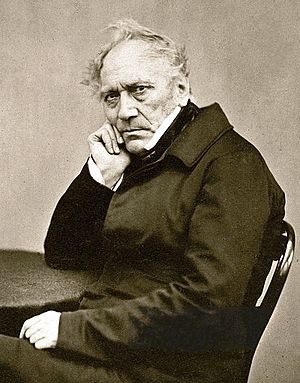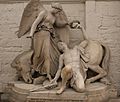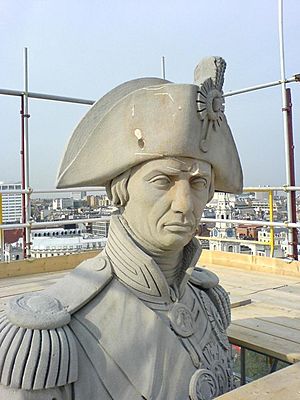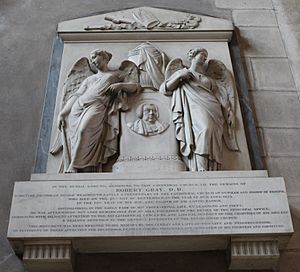Edward Hodges Baily facts for kids
Quick facts for kids
Edward Hodges Baily
|
|
|---|---|
 |
|
| Born | 10 March 1788 Bristol, England
|
| Died | 22 May 1867 (aged 79) London, England
|
| Nationality | British |
| Known for | Sculpture |
|
Notable work
|
Nelson's Column |
| Awards | FRS, Turner Gold Medal |
Edward Hodges Baily (born March 10, 1788 – died May 22, 1867) was a very busy British sculptor. He created many public statues, busts (sculptures of heads and shoulders), and art pieces. He also designed things made of silver.
Baily carved detailed friezes (long bands of sculptures) for famous London landmarks like the Marble Arch and Buckingham Palace. Some of his most well-known statues include the one of Horatio Nelson at the very top of Nelson's Column in London. He also made the statue of Charles Grey, 2nd Earl Grey on Grey's Monument in Newcastle upon Tyne. Throughout his life, Baily made many monuments and memorials for churches and cathedrals in Britain, including several in St Paul's Cathedral.
Contents
About His Life
Edward Baily was born in 1788 in Downend, near Bristol. His father, William Hillier Baily, was a woodcutter who specialized in carving figureheads for ships. When Edward was fourteen, he worked as an accounts clerk. But he loved making wax models and busts, which was his hobby since childhood.
In 1804, at age sixteen, he decided to become a professional wax portrait artist. He showed some of his work to a famous sculptor named John Flaxman. Flaxman was so impressed that in 1807, he took Baily on as a student in his London studio. Baily later became Flaxman's assistant.
Baily won several awards early in his career. In 1808, he won a silver medal from the Society of Arts. The next year, he joined the Royal Academy Schools. He won another silver medal there in 1809. In 1811, he won their gold medal for a model called Hercules restoring Alcestis to Admetus. Soon after, he showed other sculptures like Apollo discharging his Arrows against the Greeks.
From 1816 to 1846, Baily was the main designer for Rundell, Bridge and Rundell. This company made gold and silver items for the royal family. He designed important trophies like the Doncaster Cup in 1843 and the Ascot Gold Cup in 1844.
Baily also created designs for other silversmiths. For example, he designed handles for a soup tureen in 1821. These handles later inspired his large marble sculpture called Eve at the Fountain. This artwork was very popular in Britain at the time. You can see it now in the Bristol Museum & Art Gallery. Baily returned to the subject of Eve in 1842 with another work, Eve listening to the Voice. Because of his work, especially Eve at the Fountain, Baily became an Associate member of the Royal Academy in 1817 and a full Academician in 1821.
From the 1820s until 1858, Baily received many important public projects. He also made many portrait busts and exhibition pieces. He carved the detailed bas-reliefs (sculptures that stick out from a flat surface) on the front of the Masonic Hall in Bristol. He also carved those on the south side of the Marble Arch in Hyde Park in 1826. Some of his carvings for the Marble Arch were later moved to Buckingham Palace when the Arch's design changed. He also designed the stone figures for the front of Buckingham Palace and a frieze called Britannia Rewarding Arts and Sciences for the Palace's throne room.
One of his most famous works is the large statue of Horatio Nelson on top of Nelson's Column in Trafalgar Square. He also created statues and friezes for the front of the National Gallery in Trafalgar Square.
Baily showed his art at the Royal Academy regularly from 1810 to 1862. He also exhibited at the British Institution. His exhibition pieces often showed family life, with titles like Maternal Affection (mother's love) and Mother and Child. For Saint Stephen's Hall in the Palace of Westminster, he created statues of important figures like Charles James Fox and Lord Mansfield. He made busts of famous people like the Duke of Wellington and Lord Byron. Some of his designs were even made into smaller bronze statues for people to buy for their homes.
Baily sometimes had money problems. He faced financial difficulties in 1831 and again in 1838. His appeals to the Royal Academy for help were successful. They gave him money in the 1830s and later a pension in the 1860s. He became a member of the Royal Society (FRS) in 1842. One of his last designs was for the Turner medal in 1857, an award for landscape painting.
Baily married Elizabeth Wardley in 1806, and they had four children. His daughter, Caroline, married Edgar George Papworth Senior, who was one of Baily's assistants. Many other sculptors also learned from Baily, including John Henry Foley and William Theed.
Edward Baily passed away on May 22, 1867, in London. He is buried in Highgate Cemetery.
Selected Public Works
Edward Baily created many public sculptures. Here are some examples:
1815–1829
| Image | Title / subject | Location and coordinates |
Date | Type | Material | Dimensions | Designation | Wikidata | Notes |
|---|---|---|---|---|---|---|---|---|---|
 |
Memorial to Calverly Bewick | Newcastle Cathedral | After 1815 | Sculpture group on plinth | Marble | Grade I | With William Theed | ||
 |
William Ponsonby | Crypt of St Paul's Cathedral, London | 1820 | Sculpture group on plinth | Marble | ||||
 |
Bristol with Minerva and Apollo | Portico of 17 Park Street, Bristol | 1824 | Curved relief frieze | Carrara marble | 820cm long by 80cm high | Grade II* | Q17553095 | Architect;- Charles Robert Cockerell. |
 |
John Jervis, 1st Earl of St Vincent | Crypt of St Paul's Cathedral, London | 1826 | Statue | Marble | ||||
 |
Battle of St Vincent | Regent's Place Plaza, Camden, London | c. 1826 | Frieze | Marble | ||||
 |
Monument to Thomas Picton | Picton Terrace, Carmarthen | 1828 | Statue | Bronze | Statue; 9ft 6in | Monument was dismantled in 1846 | ||
 |
Valour and Virtue and Peace and Plenty | South face of Marble Arch, London | 1828 | Two reliefs | Marble | 150cm square | Grade I | Q845529 | |
 |
Pallas Athene | Athenaeum Club, London | 1829 | Gilded statue | Grade I | Q89271625 | Architect, Decimus Burton |
1830–1839
| Image | Title / subject | Location and coordinates |
Date | Type | Material | Dimensions | Designation | Wikidata | Notes |
|---|---|---|---|---|---|---|---|---|---|
 |
Pulteney Malcolm | Crypt of St Paul's Cathedral, London | 1832 | Statue | Marble | ||||
 |
Charles Grey, 2nd Earl Grey | Grey's Monument, Newcastle upon Tyne | 1838 | Statue | Marble | Grade I | Q5608058 | ||
 |
Thomas Telford | Westminster Abbey, London | 1839 | Statue on pedestal | Marble | ||||
 |
Horatio Nelson | Nelson's Column, London | 1839-42 | Statue | Craigleith stone | Grade I | Q2447876 |
1840–1849
| Image | Title / subject | Location and coordinates |
Date | Type | Material | Dimensions | Designation | Wikidata | Notes |
|---|---|---|---|---|---|---|---|---|---|
 |
Astley Cooper | St Paul's Cathedral, London | 1842 | Statue | Marble | ||||
 |
Richard Bourke | Sydney, Australia | 1842 | Statue on pedestal | Bronze & stone | ||||
 |
Dr Isaac Watts | Abney Park Cemetery, Stoke Newington, London | 1845 | Statue on pedestal | Stone | Grade II | Q26528763 | ||
 |
David Hare | Hare School, Kolkata | 1845 | Statue on pedestal | Marble | KMC Grade 1 | Q68148800 |
1850 and later
| Image | Title / subject | Location and coordinates |
Date | Type | Material | Dimensions | Designation | Wikidata | Notes |
|---|---|---|---|---|---|---|---|---|---|
 |
Nicholas Conyngham Tindal | Tindal Square, Chelmsford, Essex | 1850 | Seated statue on pedestal | Bronze & stone | Grade II | Q26391312 | ||
 |
Statue of Robert Peel | Market Place, Bury, Greater Manchester | 1852 | Statue on pedestal with relief panels | Bronze & granite | Grade II | Q7160232 | ||
 |
George Stephenson | National Railway Museum, York | 1852 | Statue on pedestal | Marble & stone | Relocated from Euston Station, London | |||
 |
Lord Mansfield | St Stephen's Hall, Westminster, London | 1855 | Statue on pedestal | Marble | ||||
| Charles James Fox | St Stephen's Hall, Palace of Westminster, London | 1856 | Statue on pedestal | Marble |
Church Monuments and Memorials
Edward Baily created many monuments and memorials for churches and cathedrals across Britain.
Some examples include:
- A tablet with two marble angels for Samuel Paynter at St Mary Magdalene, Richmond.
- Memorials in churches like St Nicholas, Lintn Hill, Maidstone, and St John the Baptist, Devizes.
- A memorial with a kneeling female figure at the Church of the Holy Trinity, Ardington, Oxfordshire.
- Memorials to Peter Denys and Lady Charlotte Denys at the Church of St Mary, Easton Neston, Northamptonshire.
- A memorial with a carved figure from 1846 at the Church of St Mary, Hertfordshire.
Other Works
Baily also created many other sculptures, including:
- Busts of Lord Byron (1826) at Harrow School and Newstead Abbey.
- A bust of Michael Faraday (1830) at the University Museum, Oxford.
- A bust of Richard Owen (1846) at the Royal College of Surgeons.
- Eve listening to Adam at the Victoria and Albert Museum, London.
- A marble bust of Charles Metcalfe, 1st Baron Metcalfe (1844) at the Victoria Memorial, Kolkata.
- A sculpture called Justice at the Old Council House, Bristol.
- Five statues representing Christ and the Evangelists at the Church of St Margaret at Grittleton, Wiltshire.
- A marble bust of his mentor, John Flaxman, at the Royal Academy.



